Last Updated on August 22, 2023 by kiezelamquiz
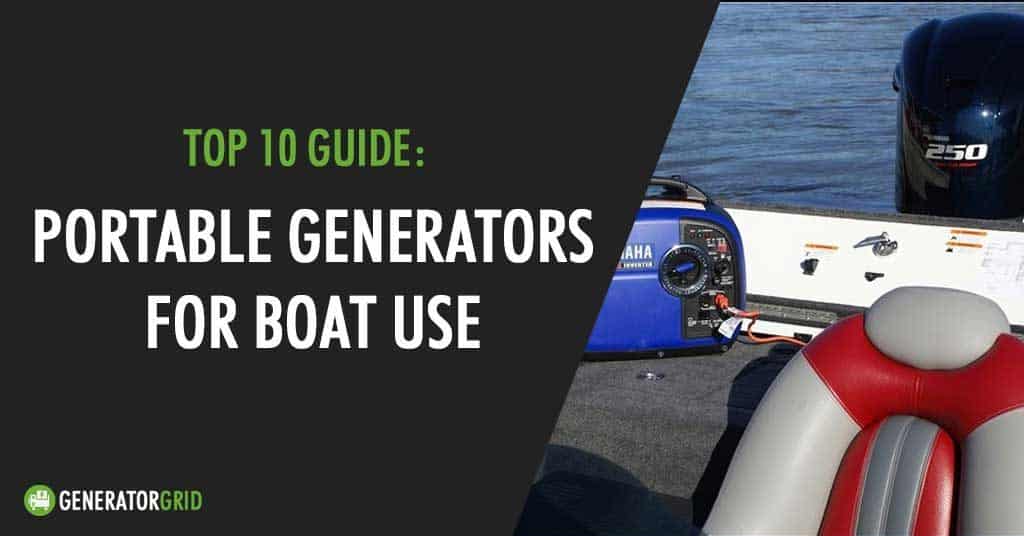
In this post I’m going to cover the best boat generators to use aboard your sailboat, fishing boat, battleship, or any small marine vessel you might need some power on.
I spent dozens of hours researching marine generators, so I hope you find my picks helpful.
Using a portable generator on a boat can open up several possibilities.
Being able to power a microwave, coffeemaker, or air conditioner can feel luxurious.
Powering lights for night fishing is another great use for a portable generator on a sailboat or other watercraft. A generator on the boat can also provide peace of mind as a backup for charging your battery or calling for help if the boat dies on the water.
However, using a portable generator on a boat can be dangerous, and there are some important safety and usage considerations to note.
On this page, you’ll see some of the best portable generators for boat use and a buying guide that includes safety tips.
The Best Portable Generators for Boats
1. Honda EU2200i – A Quiet Bestseller
Honda’s line of portable generators has long been best sellers for use on land.
This 2,200-watt inverter is also an ideal candidate for maritime use.
One big selling point for boat use is that this generator is super quiet. While docked, you don’t want to bother other boaters anchored nearby.
This generator is shockingly quiet, at only 48 to 57 dBA, which is no louder than the sound of a typical conversation.
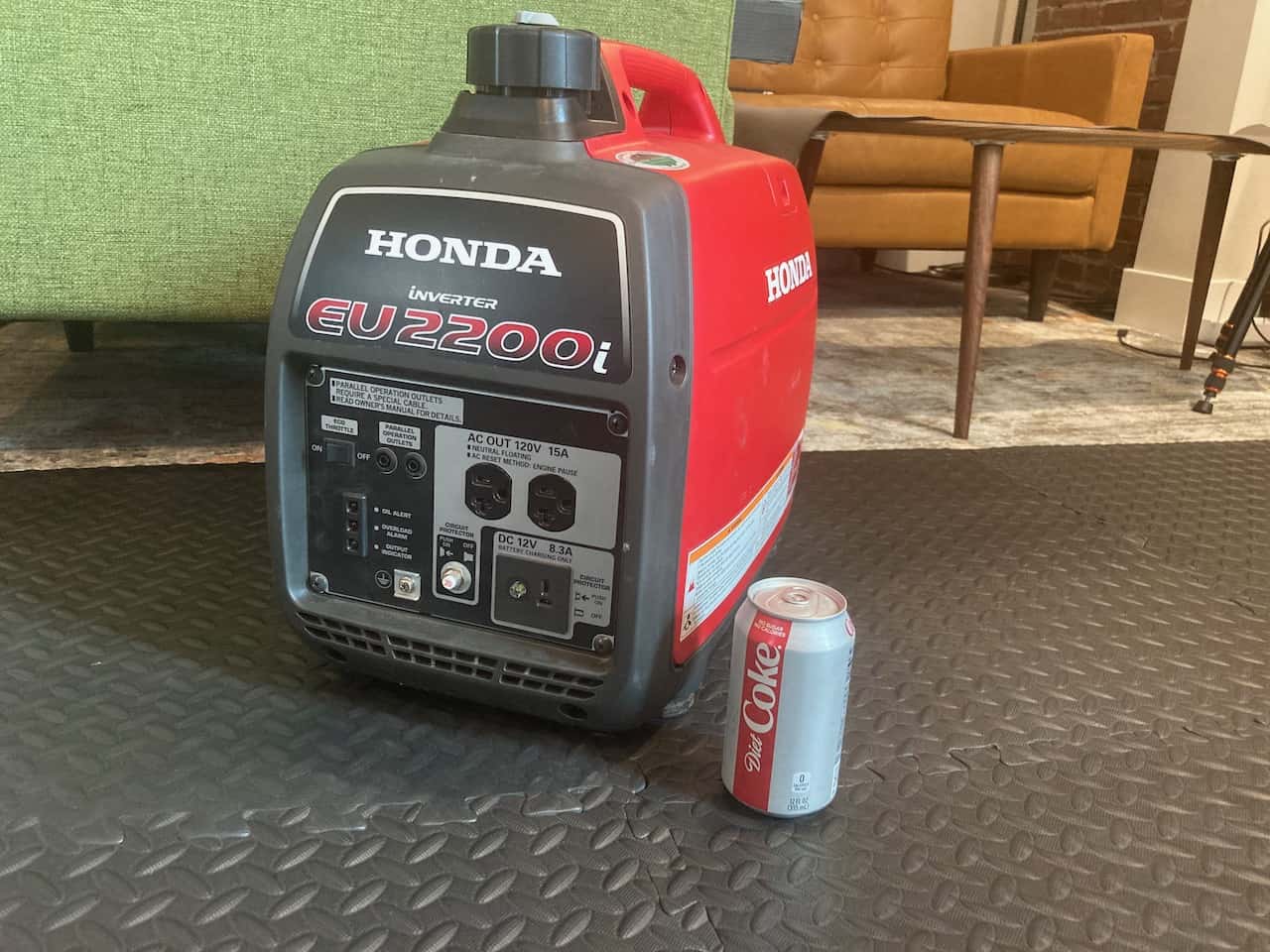
A fuel-efficient model, you can get 4-9+ hours on a single tank of gas.
Because this is an inverter, you’ll get clean and stable power that will let you plug in your sensitive electronics without worry.
The eu2200i has 2,200 starting watts and 1,800 rated watts. This model is an updated version of the eu2000i.
In addition to offering a bit more power, there are additional improvements as well, such as better ventilation.
Good ventilation is particularly important on a boat; it makes the generator safer to use in the unique marine environment.
Pros
- Relatively lightweight and easy to transport
- Extremely quiet
- Inverter technology = clean power
- Fuel-efficient
- Parallel-ready if you want to use two for more power
Cons
- No fuel gauge or hour meter
IMHO: In My Humble Opinion
Honda is a proven leader in the portable generator market, and the Honda eu2200i is definitely part of the club. It’s a standout choice for boat use because it is extremely quiet and is easily transportable. Click here to read my full review of the Honda EU2220i generator
2. WEN 56200i – A Quiet & Affordable Inverter
For a significantly lower price, this generator provides some big competition for the Honda eu2200i.
Like the Honda, it is relatively lightweight and easily transportable.
Getting it on and off the boat (and from boat storage to the deck) would be quite easy.
It’s not quite as quiet as the Honda, but it is not nearly as loud as many other generators. At a quarter load, it’s only 51 decibels.
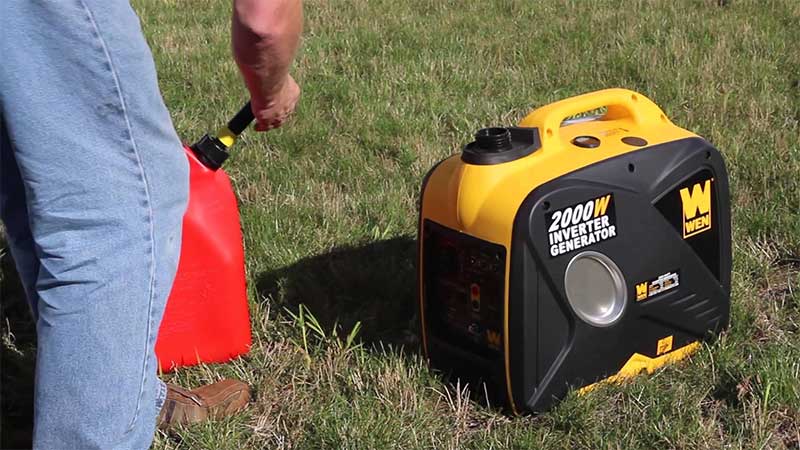
Sensitive electronics are safe, as the generator is an inverter. It is designed to mirror a pure sine wave and limits harmonic disruption. At a half-load, you can expect around 6 hours of runtime.
The generator’s fuel efficiency can be maximized by using eco mode.
For more power, you can hook up a second unit using a Parallel Connection Kit.
Some safety features, like automatic shutdown when oil or fuel are low, are built right into this model.
Pros
- Great value – affordable price point
- Relatively lightweight and easy to transport
- Inverter technology protects sensitive electronics
- Eco mode maximizes fuel efficiency
- 2-year warranty and excellent customer service
Cons
- To check/change oil, you have to remove the full panel
- While inverter energy produced is clean, it’s not technically a pure sine wave
IMHO: In My Humble Opinion
For an almost too-good-to-be-true price, the WEN 56200i portable generator offers quiet operation, clean power, and a fuel-efficient eco-mode. It’s a great option for the boater who doesn’t have a lot to spend. Click here to read my full review of the WEN 56200I
3. Yamaha EF2000iS V2 – Clean Power & Cute Design
What your generator looks like probably shouldn’t matter, but if design is important to you, this might be the generator you’re looking for.
Reminiscent of a retro radio, this royal blue inverter from Yamaha is a great-looking tool.
Transport is easy as well since it is compact, lightweight, and has a convenient handle. It’s more than just a pretty face, though.
This inverter offers clean power and Pulse Width Modulation control.
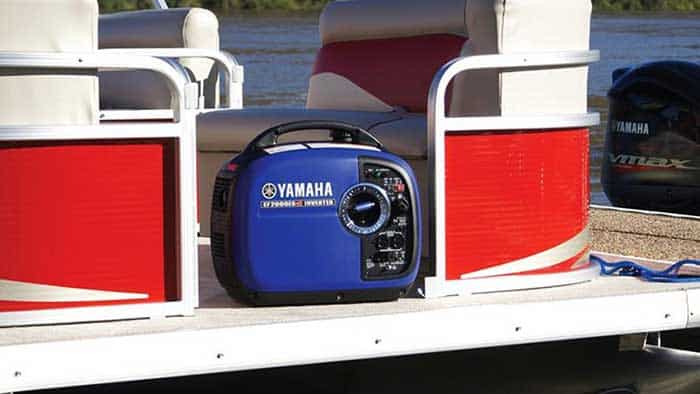
With 2,000 max watts and 1,600 running watts, it has enough power for most boaters.
If desired, this generator is parallel-ready so you can double the power output available.
The fuel economy is very good thanks to the Smart Throttle.
The fuel efficiency is so good, in fact, that you can get a 10.5-hour runtime on a quarter-load.
Pros
- Attractive design
- Good fuel efficiency, long runtime
- Easy to transport, with lightweight and compact design
- Helpful features like fuel gauge and low-oil auto shutoff
- Quiet operation
Cons
- Have to remove panel to check oil
- Gas tank could be a bit bigger
IMHO: In My Humble Opinion
The Yamaha EF2000iSV2 offers clean power in a stylish package while also being compact and lightweight. Click here to read my full review of the yamaha EF2000ISV2.
4. Generac iQ2000 – Quiet, Smart, User-Friendly
Other brands aim to best Honda in the portable generator game. Generac goes so far as to use bold Honda comparisons in their marketing materials.
Generac claims that the iQ2000 unequivocally “beats Honda.” At least when it comes to noise level, an independent testing lab has confirmed that at a half-load, the Generac is indeed quieter than the Honda EU generator line.
They aren’t much quieter, but they can boast the title.
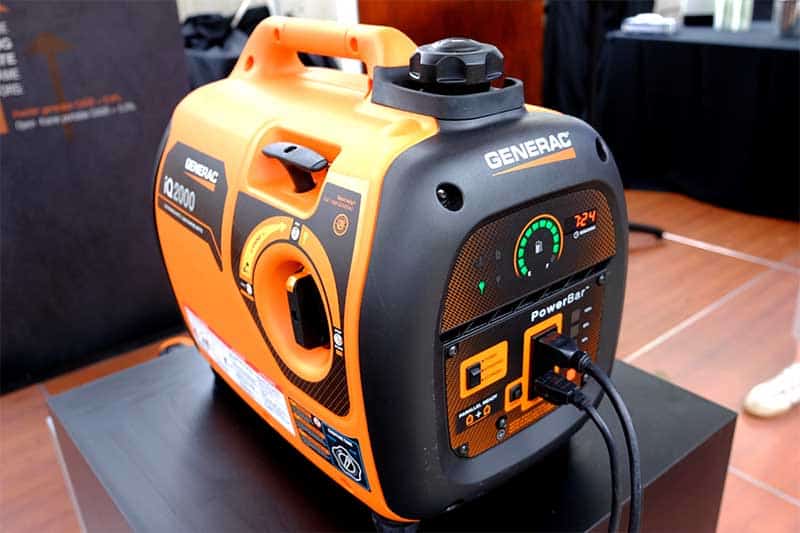
In addition to being quieter, Generac celebrates their “smart” panel.
This is for sure more helpful and user-friendly than what you’ll see on many competing generators.
It includes an electronic fuel gauge, a runtime hour meter, status lights, and a Powerbar.
In addition, it’s easy to start and operate.
The small marine gas generator has a simple dial with three positions – start, run, and stop.
There is also a toggle switch for the three modes of turbo, standard, and economy.
This isn’t a true inverter but it does offer clean and stable power thanks to a digital inverter module.
At a quarter-load, you’ll get 7.7 hours of runtime. The iQ2000 is yet another generator with 2,000 starting watts, 1,600 running watts, and parallel-ready functionality.
Pros
- Very user-friendly operation with helpful control panel
- Clean and stable power
- Good value
- Fairly easy to transport
- Decent fuel efficiency
Cons
- There have been some troubling quality control issues, including fuel leaks
- Customer service tends to be poor
- Power is stable but not a pure sine wave
IMHO: In My Humble Opinion
The moderately priced Generac iQ2000 makes some big claims, and it definitely lives up to some of them. If it weren’t for a few potentially big negatives, this smart and quiet generator would be at the top of every list. Click here to read my full review on the Generac IQ2000 generator
5. Telongpu Emergency Solar-Powered Generator – Low-Cost Tool for Emergency Preparedness
If the only reason you’re looking for a portable generator to use on a boat, barge, or catamaran is for emergency preparedness, there’s no need to waste your money on an expensive, high-powered machine.
This ultra-low-cost solution only offers 200 watts of power, which won’t be enough for much, but it is enough to power a phone or radio if you run into trouble while sailing.
It might even be enough to charge your boat battery enough to start if you die out on the water.
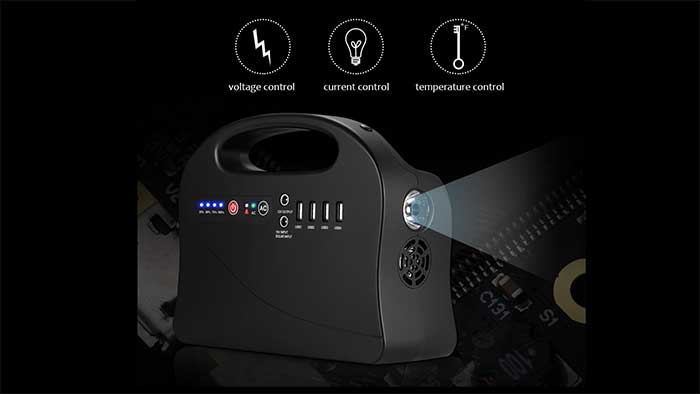
This generator is safer to use on the water than gas-powered generators.
To charge it, you can either connect it to a solar panel and harness the power of the sun or charge it using a wall outlet or a vehicle adapter.
For boat use, it makes the most sense to use the solar panel. It’s also smart to fully charge from a wall outlet before getting on the boat.
This emergency solution also has many safety precautions, including overload, over-current, over-voltage, overcharging, over-temperature, and short circuit.
It has four USB outputs as well as one 12V output. There is also a 15V solar input.
This is more than just a generator, as it also has a flashlight and a compass.
A low-cost investment to begin with, you get added value because of the lifetime warranty and excellent customer support.
Pros
- Low cost plus lifetime warranty
- Solar-power option
- Many safety features
- Great for charging electronics, with 4 USB ports
- Ultra lightweight and compact
- Includes flashlight and compass
Cons
- Have to buy solar panel separately
- Not much power
- It’s really more of a battery pack than a generator
IMHO: In My Humble Opinion
To actually call the Telongpu Emergency Solar-Powered Generator a generator is a big stretch but it is a very good backup power source solution for emergency preparedness on a boat. The biggest negative for using this on a boat is that you’ll have to buy a solar panel separately.
6. DuroStar DS4000S – Low-Cost + High-Power
Generally speaking, a generator that is more lightweight and compact is a smarter choice for a dinghy, barge, pontoon boat and other smaller ships.
However, sometimes you just need more power. If you want a generator that can power an air conditioning unit on your yacht, for example, a smaller generator just isn’t going to cut it.
This generator from DuroStar is definitely bulkier and heavier than some other options on this list. That said, it has a dual-handle system that makes it fairly easy for two people to carry.
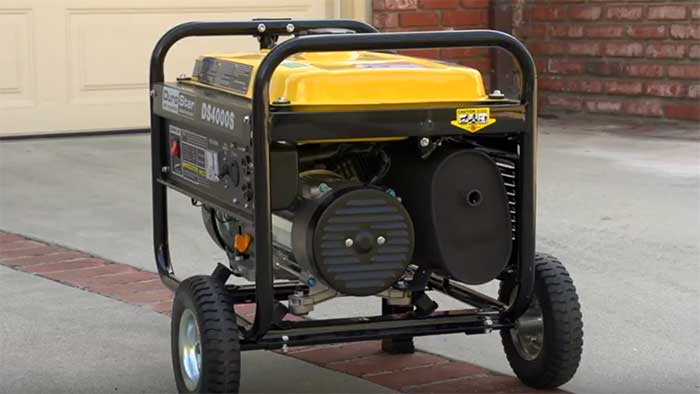
There is an optional wheel kit as well that may or may not make sense on a boat.
With 4,000 starting watts and 3,300 running watts, it has plenty of power.
DS4000S generator is a lot quieter than you might expect, at only 69 dBA.
That’s louder than some other models, to be sure, but it’s very quiet for a generator with this size of power output. The construction is very sturdy and stable.
It’s not quite as fuel-efficient as some other options, but the 4-gallon gas tank can get you an 8-hour runtime.
This generator comes in at a surprisingly low price point, but it definitely does not lack in quality.
DuroStar is known for putting out very solid generators.
Pros
- Low cost
- Solid build quality
- Plenty of power
- Dual-handle makes carrying it relatively easy despite the weight
- Surprisingly quiet
Cons
- Placement of oil drain is problematic
- Requires grounding which can be tricky on a boat
- No hour meter
IMHO: In My Humble Opinion
The DuroStar DS4000S might be a bit unwieldy to maneuver on a boat, but it is a low-cost, high-power solution that shouldn’t be ignored. Click here to read my full review of the DS4000S generator
7. Honda Power Equipment EB3000C – High-Powered but Pricey
With 3,000 starting watts and 2,600 running watts, this is another generator that gives you a lot of power.
Ideal for industrial use, it also works well on a boat, especially for when you need it for powering air conditioning units, lights, and other things that require a fair amount of power.
This high-powered machine offers very good fuel efficiency. The 2.6-gallon gas tank will get you 9.4 hours of runtime on a half-load.
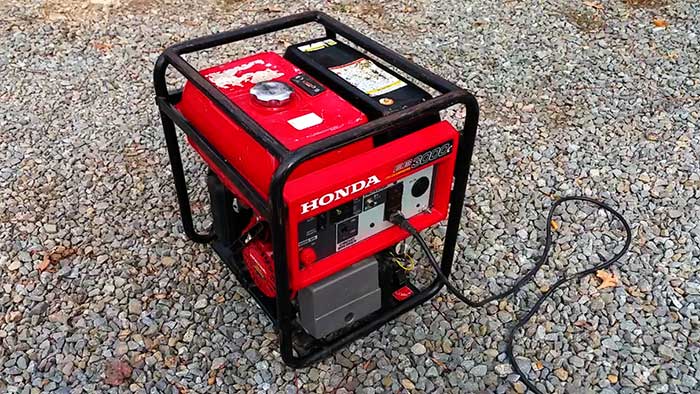
You’ll get clean and stable power with this generator, thanks to Honda’s exclusive CycloConverter technology.
This generator looks like it would be really heavy but it’s surprisingly light.
At only 71 pounds, it’s the lightest industrial generator on the market.
The multi-handled frame makes carrying it easy, especially with two people.
You can also buy an optional wheel kit to make it even easier to move around.
For a heavy-duty generator, it’s not as loud as you might expect.
A rated load is only 65 dB, less than the noise level of a typical vacuum cleaner.
This generator isn’t cheap, but it’s an investment that you can count on. Honda even backs it up with a great 3-year warranty.
Pros
- Safety features like built-in GFCI
- Fuel-efficient
- 3-year warranty
- For size and power, it’s lightweight
Cons
- Expensive
IMHO: In My Humble Opinion
The Honda EB3000C is a powerful generator that provides a fuel-efficient source of stable power you can count on, but it is expensive and may be too bulky for some boats.
8. Champion 3100-Watt Inverter – Convenient Remote Start
Most generators have recoil pull starters so this Champion inverter really stands out for having a remote start.
This generator does still have a recoil starter but it also lets you use a wireless remote key fob to start the generator from up to 80 feet away.
It also features Cold Start Technology, so the engine will start right up even when it is cold. This inverter provides very stable and clean power.
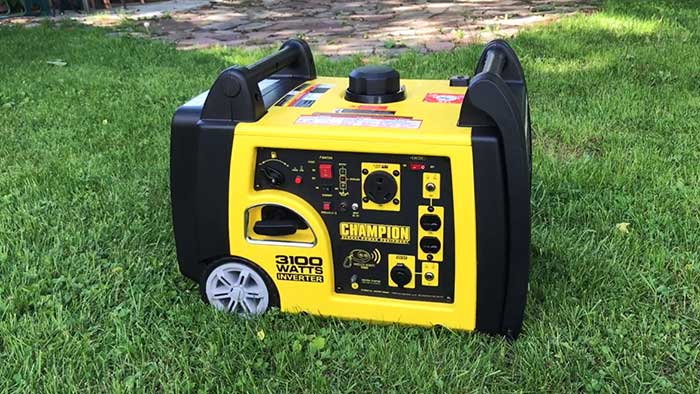
If you’re addicted and need your smartphone or iPad even on a fishing trip, you can rest easy knowing that your sensitive electronics will be safe.
With 3,100 starting watts and 2,800 running watts, you’ll have all the power you need on the boat, even when running several things at once.
This generator is tough, reliable, and durable.
Adding to your peace of mind with this reasonably priced generator, Champion offers a 3-year limited warranty and free lifetime technical support.
At only 58 dBA, this heavy-duty generator is also shockingly quiet.
Pros
- 3-year limited warranty and free lifetime technical support
- Remote key start
- Clean and stable power and plenty of it
- Solid build quality overall, durable
- Very reasonably priced – great value
Cons
- Wheel placement makes it tricky to carry
- A few of the parts feel a bit cheap
IMHO: In My Humble Opinion
The high-value Champion 3100-Watt Inverter gets great reviews for a reason. It is a powerful generator with the convenience of a remote start and more.
9. WEN PowerPro 56101 – Inexpensive & Ultra-Portable
With 1,000 starting watts and 900 running watts, this highly affordable generator provides just enough power for most needs.
Weighing less than 36 pounds and equipped with a convenient handle, this is as easily portable as it gets.
It also has 4 rubber pads or legs that keep it stable and held in place pretty well.

That said, you’ll still want to secure it in some way on the boat so the lightweight machine doesn’t get knocked over or jostled in a strong wind.
This generator is very unique in not ever needing oil changes since it runs on an oil/gas mix fuel.
At a half-load, the 1-gallon tank will last you about 5 hours. It’s fairly quiet, at only 60dB.
This generator is both EPA- and CARB-compliant. There is a 1-year limited warranty from the manufacturer.
Pros
- Unique fuel system means no oil changes
- Extremely portable
- Decent fuel efficiency
- Low cost
Cons
- Not an inverter – not good for sensitive electronics
- It can be difficult to start
IMHO: In My Humble Opinion
The low-cost WEN PowerPro 56101 would be even better if it was an inverter but it does offer extreme portability and a decent amount of power.
10. Westinghouse WGen7500DF Dual-Fuel Portable Generator – Propane Possibilities & Maximum Power
This dual-fuel generator allows you to use either gasoline or liquid propane gas.
Ultimately, this gives you options and can allow for longer runtime.
If you have a full 6.6-gallon tank of gas plus a tank of propane, you can expect over 24 hours of total runtime.
The fuel efficiency with a full tank of gas alone will get you 16 hours of runtime.
In addition to giving you more possibilities and having extra long runtimes, this generator has a ton of power.
When using gasoline, it has 9,500 peak watts and 7,500 running watts.
With propane, you’ll get 8,550 starting watts and 6,750 running watts.
The GFCI power outlets are rubber-covered for added safety.
This generator features rugged construction with a hardened-steel frame for sturdiness and durability.
A convenient push-button electric start is a great feature. Although not cheap, this high-value generator is surprisingly affordable.
Adding to the value, there is a 3-year limited warranty.
Pros
- Dual fuel possibilities and great fuel efficiency
- 3-year limited warranty
- Push-button electric start
- Solid build quality, durability
Cons
- Quite heavy, might be difficult to maneuver on boat
- A bit loud
IMHO: In My Humble Opinion
The Westinghouse WGen7500DF Dual-Fuel is heavy and a bit loud, so it might not be ideal for all boats and boaters, but it’s a great value that offers a ton of power and all the possibilities of dual-fuel capability.
Buyer’s Guide & Frequently Asked Questions
What is Marinizing a portable generator?
Before adding any portable generator to your boat, you’ll need to marinize it.
This involves taking it apart and covering electrical connectors, screws, and hardware with products like Boeshield T-9 and RustOleum.
Marinizing your generator ensures that it is as safe as possible for the unique environment of a boat.
This video walks you through the process of marinizing your generator:
You shouldn’t try to permanently install the generator on your boat.
Rather, you should keep it in a dry storage locker when not in use.
When you are anchored, running the generator in the aft position will ensure the wind carries away the carbon monoxide.
The swim platform is a good place to run your generator as well.
You might want to non-permanently mount the generator to the deck.
A bracket and rubber mounts in front of the cockpit make sure that the generator is secure and safe.
It’s also a good idea to build a cowling to protect it from getting wet while running.
If you’re interested, consider reading how a marine generator is different from a regular generator.
How do I ground my portable generator in a boat?
For portable generators that typically need to be ground to the earth, you might think there’s no way to do this on a boat.
It will depend on the generator and the boat, but typically, grounding a generator on a boat will work through shore power connection.
It’s a good idea to use a mains tester. Your best bet might be to just use a portable generator that doesn’t require grounding, like the Honda eu2200i.
How do I keep things safe while running my marine generator?
Safety is always important when using a generator and when on a boat.
When using a generator to power your boat at shore, safety is even more important. In addition to following all of the regular safety tips for a portable generator on land, there are additional things to consider for boat use.
To avoid fire, prevent carbon monoxide poisoning, and prevent electrocution, it’s important to follow these safety tips.
You might also want to learn about running a boat generator while underway.
Refueling & Running
You should not refuel your generator while it is on the boat.
Instead, you should remove it from the boat to fill up so as to avoid potential sources of ignition.
You should never run the generator near doors, vents, windows, and hatches, so as to prevent the cabin from filling with carbon monoxide.
It’s also important that you know the symptoms of carbon monoxide poisoning.
If you know what it looks like, you’ll be able to get help faster and potentially save lives. Before starting your generator, it’s vital that you make sure there aren’t any damp patches nearby.
You should also always thoroughly inspect the unit to make sure there isn’t a fuel leak.
It’s a good idea to invest in a ground fault circuit interrupter circuit breaker as well. While most generators have circuit breakers, a GFCI is an extra level of protection.
Some generators have one of these circuit interrupters built right in, like the Honda EB3000c, or will at least have GFCI outlets.
Storage
Storage is another consideration.
Make sure your generator is put in a drained locker that doesn’t include any tools, anchors, mooring pins, or petrol cans.
This is to prevent damage or sparks that could cause a fire.
Finally, you should never install a portable generator permanently on your boat or make any unauthorized modifications to the generator.
That said, it is smart to build some kind of cowling that you can use to prevent the generator from getting wet while in use.
Obviously, getting wet is a very real possibility on a boat, so it’s vital that you take steps to prevent this or you’ll risk serious damage and danger. Another good idea is some kind of rubber mounts.
For a more general article about smaller portable inverters, check out my top 10 best portable generator buying guide.
Have you ever used a portable generator on a boat? Do you have any tips? Please share in the comments! Do you have your eye on any of these generators? What will you use it for on your boat?
GeneratorGrid.com is an independent review business. I am not affiliated with any manufacturers and do not accept paid reviews. When you buy through my links, I may earn a commission which helps me purchase more generators for testing. - Scott Krager



Hello, and thank you for for all the info and advice.
I just bought a bigger boat and my engine compartment has plenty of room for a generator.
I was thinking of building a box with a lid, and ventilated to the back of the boat, as it’s already has a big opening assuming that it’s for a marine generator exhaust.
I was thinking of placing a portable generator in the box so that way it will be more quiet.
I can always ad a small blower motor on the vent and have it running as soon as I start the generator.
Your opinion and thoughts will be appreciated.
Thank you.
Hey Chris
You can buy a special box that will do the job or make one yourself and add Fire Proof sound mats which are made with generators in mind.
Make sure it have plenty of ventilation and is made from a fire retardant material. There are some on Amazon perfect for the job.